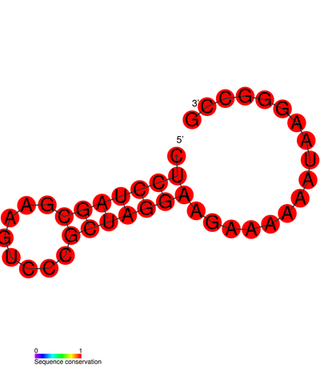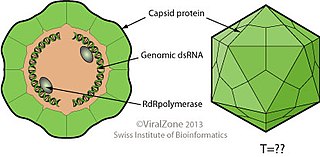
Parvoviruses are a family of animal viruses that constitute the family Parvoviridae. They have linear, single-stranded DNA (ssDNA) genomes that typically contain two genes encoding for a replication initiator protein, called NS1, and the protein the viral capsid is made of. The coding portion of the genome is flanked by telomeres at each end that form into hairpin loops that are important during replication. Parvovirus virions are small compared to most viruses, at 23–28 nanometers in diameter, and contain the genome enclosed in an icosahedral capsid that has a rugged surface.

Closterovirus, also known as beet yellows viral group, is a genus of viruses, in the family Closteroviridae. Plants serve as natural hosts. There are 17 species in this genus. Diseases associated with this genus include: yellowing and necrosis, particularly affecting the phloem. This genus has a probably worldwide distribution and includes among other viral species the Beet yellows virus and Citrus tristeza virus, rather economically important plant diseases. At least some species require vectors such as aphids or mealybugs for their transmission from plant to plant.
Amdoparvovirus is a genus of viruses in the family Parvoviridae in the subfamily Parvovirinae. Mustelids, skunk, and raccoons serve as natural hosts. There are five species in this genus. Diseases associated with this genus include progressive disorder of immune system.

Ourmiavirus is a genus of positive-strand RNA viruses. Cucurbits, cherry, and cassava serve as natural hosts. There are three species in this genus. Diseases associated with this genus include: OuMV: yellowing and chlorotic spot symptoms.

Erythroparvovirus is a genus of viruses in subfamily Parvovirinae of the virus family Parvoviridae. Primates serve as natural hosts. There are seven species in this genus. Diseases associated with this genus include fifth disease and skin lesions.
Hypovirus is a genus of viruses, in the family Hypoviridae. Fungi serve as natural hosts. There are four species in this genus. Infection reduces the virulence of its parasitic host, making it a hyperparasite useful for blight control.
Bocaparvovirus is a genus of viruses in the subfamily Parvovirinae of the virus family Parvoviridae. Humans, cattle, and dogs serve as natural hosts. There are 28 species in this genus. Diseases associated with this genus include, in humans, acute respiratory illness, and in cattle, diarrhea and mild respiratory symptoms.
Densovirinae is a subfamily of single-stranded DNA viruses in the family Parvoviridae. The subfamily has 11 recognized genera and 21 species. Densoviruses are known to infect members of insect orders Blattodea, Diptera, Hemiptera, Hymenoptera, Lepidoptera, and Orthoptera, while some viruses infect and multiply in crustaceans such as shrimp or crayfish, or sea stars from phylum Echinodermata.

Protoparvovirus is a genus of viruses in the Parvovirinae subfamily of the virus family Parvoviridae. Vertebrates serve as natural hosts. There are 15 species in the genus including Rodent protoparvovirus 1 for which the exemplar virus is minute virus of mice (MVM). This genus also includes canine parvovirus (CPV), which causes gastrointestinal tract damage in puppies that is about 80% fatal, and porcine parvovirus (PPV), which is a major cause of fetal death and infertility in pigs. The genus divides phylogenetically into two branches, one that contains many founder members of the family, such as MVM, CPV and PPV, which have been studied in considerable detail, and a second branch occupied exclusively by predicted viruses whose coding sequences were identified recently in the wild using virus discovery approaches, but whose biology remains minimally explored. This second branch currently contains two species whose members infect humans, called Primate protoparvovirus 1 and Primate protoparvovirus 3. Until 2014, the genus was called Parvovirus, but it was renamed to eliminate confusion between members of this genus and members of the entire family Parvoviridae.
Aquabirnavirus is a genus of viruses, in the family Birnaviridae. Salmonid fish serve as natural hosts. There are three species in this genus. A disease associated with this genus, Infectious pancreatic necrosis (IPN) in salmonid fish, causes significant losses to the aquaculture industry. Chronic infection in adults, and acute viral disease in young salmonid fish can occur.
Betapapillomavirus is a genus of viruses, in the family Papillomaviridae. Human serve as natural hosts. There are six species in this genus. Diseases associated with this genus include warts, papilloma, and malignant tumours.
Brevihamaparvovirus is a genus of viruses in subfamily Hamaparvovirinae of the family Parvoviridae. Mosquitoes serve as natural hosts. There are two species in this genus.
Epsilonpapillomavirus is a genus of viruses, in the family Papillomaviridae. Cattle serve as natural hosts and it is one of the bovine papillomaviruses. There are two species in this genus. Diseases associated with this genus include: fibropapillomas and true epithelial papillomas of the skin.
Iotapapillomavirus is a genus of viruses, in the family Papillomaviridae. Rodents serve as natural hosts. There are two species in this genus. Diseases associated with this genus include: cutaneous lesions and benign skin tumours, such as papillomas and keratoacanthomas.
Iteradensovirus is a genus of viruses in the subfamily Densovirinae of the family Parvoviridae. Insects serve as natural hosts. There are five species in this genus.
Mupapillomavirus is a genus of viruses in the family Papillomaviridae. Humans serve as natural hosts. There are three species in this genus. Diseases associated with this genus include palmoplantar warts.

Megabirnaviridae is a family of double-stranded RNA viruses with one genus Megabirnavirus which infects fungi. The group name derives from member's bipartite dsRNA genome and mega that is greater genome size than families Birnaviridae and Picobirnaviridae. There is only one species in this family: Rosellinia necatrix megabirnavirus 1. Diseases associated with this family include: reduced host virulence.
Copiparvovirus is a genus of viruses in subfamily Parvovirinae of the virus family Parvoviridae. Pigs and cows are known to serve as natural hosts. There are seven species in this genus.
Hepanhamaparvovirus is a genus of viruses that belongs to the Hapanhamavirinae subfamily of the family Parvoviridae. Insects and shrimps serve as natural hosts. Infection leads to mortality in the early larval and postlarval stages of the shrimp. There is only one species in this genus: Decapod hepanhamaparvovirus 1.
Penstylhamaparvovirus is the name of a genus of viruses in the subfamily Hamaparvovirinae of the virus family Parvoviridae. Shrimps and insects serve as natural hosts. There is only one species in this genus: Decapod penstylhamaparvovirus 1.




